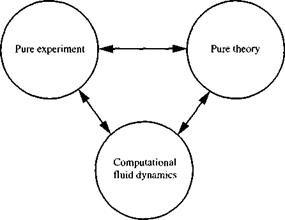The Bigger Picture
The evolution of our intellectual understanding of aerodynamics is over 2500 years old, going all the way back to ancient Greek science. The aerodynamics you are studying in this book is the product of this evolution. (See Reference 62 for an indepth study of the history of aerodynamics.) Relevant to our current discussion is the development of the experimental tradition in fluid dynamics, which took place in the middle of the seventeenth century, principally in France, and the introduction of rational analysis in mechanics pioneered by Isaac Newton towards the end of the same century. Since that time, up until the middle of the twentieth century, the study and practice of fluid dynamics, including aerodynamics, has dealt with pure experiment on one hand and pure theory on the other. If you were learning aerodynamics as recently as, say 1960, you would have been operating in the “two-approach world” of theory and experiment. However, computational fluid dynamics has revolutionized the way we study and practice aerodynamics today. As sketched in Figure 2.44, CFD is today an equal partner with pure theory and pure experiment in the analysis and solution of aerodynamic problems. This is no flash in the pan—CFD will continue to play this role indefinitely, for as long as our advanced human civilization exists. Also, the double arrows in Figure 2.44 imply that today each of the equal partners constantly interact with each other—they do not stand alone, but rather help each other to continue to resolve and better understand the “big picture” of aerodynamics.
|
Figure 2.44 The three equal partners of modern aerodynamics. |
2.18 Summary
Return to the road map for this chapter, as given in Figure 2.1. We have now covered both the left and right branches of this map and are ready to launch into the solution of practical aerodynamic problems in subsequent chapters. Look at each block in Figure 2.1; let your mind flash over the important equations and concepts represented by each block. If the flashes are dim, return to the appropriate sections of this chapter and review the material until you feel comfortable with these aerodynamic tools.
For your convenience, the most important results are summarized below:












